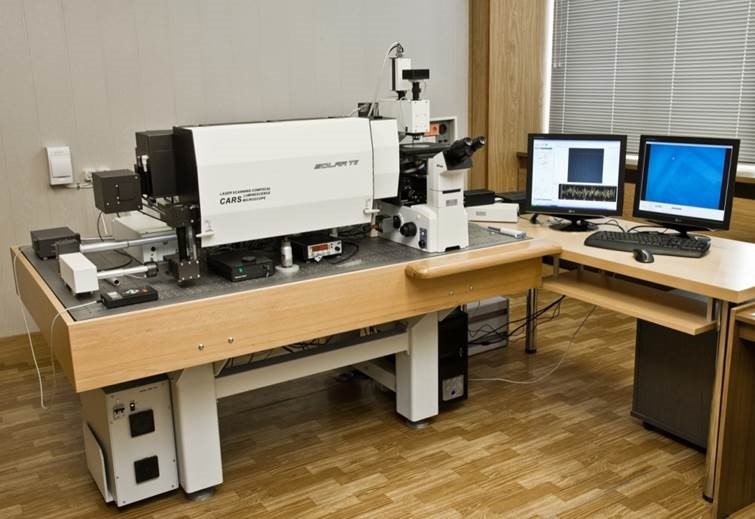The basic facility of the Sector of Raman spectroscopy (Centre "Nanobiophotonics") is a multimodal optical platform – "CARS" microscope (Fig.1). It allows to perform Raman spectroscopy and microscopy study of different materials (solids, liquids, powders, various biological samples) using spontaneous and coherent antiStokes Raman scattering options. Surface enhanced Raman scattering (SERS) and photo-/upconversion luminescence investigations are the other important parts of our research activities.

Fig. 1. General view of the "CARS" microscope.
The development of coherent laser radiation sources in the early 60’s of the last century greatly stimulated the study of nonlinear resonance processes. For the excitation of nonlinear signals high-intensity picosecond or femtosecond lasers are used, which can simultaneously initiate several nonlinear optical phenomena: harmonic generation (SHG, THG), two-photon excited fluorescence (TPEF), coherent anti-Stokes Raman scattering (CARS), etc.
CARS is a third-order nonlinear optical process involving interactions between a pump beam of frequency ωp, a Stokes beam of frequency ωs, and a CARS signal at the anti-Stokes frequency of ωas=2ωp-ωs generated in the phase matching direction (Fig.2).
Fig. 2 Energy diagram of CARS process
The vibrational contrast in CARS is created when the frequency difference Δω=ωp-ωs between the pump and the Stokes beams is tuned to be resonant with a given vibration mode of a selected chemical bond. In this case the resonant oscillators are coherently driven by the excitation fields, thereby generating a strong and directed anti-Stokes signal compared to a weak spontaneous Raman signal (most molecules have a small Raman cross section, typically ~ 10-30 to 10-25 cm2). CARS signals are 3-4 orders of magnitude stronger than those of a spontaneous Raman process.
Fig.3 Layout of the "CARS" microscope
In our confocal laser scanning microscope a picosecond Nd:YVO4 tunable laser (EKSPLA, PT257-SOPO, Lithuania) with a pulse width of ~6 ps and a repetition rate of 85 MHz is used as the source of the Stokes wave (ωs) and is simultaneously used to synchronously pump an intracavity-doubled crystal optical parametric oscillator (SOPO) (Fig.3). Thereby, the SOPO coherent device provides temporal synchronization with the Nd:YVO4 and serves as a source of the pump beam (ωp) tunable from 690 nm to 990 nm with a maximum output power of 200mW with a nearly Fourier transform-limited linewidth of ~6cm-1. For the spontaneous Raman scattering and SERS experiments we used He-Ne laser (633nm) or diode pump green laser operating at 532 nm wavelength.


